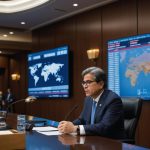
FED cut and Japan’s economic uncertainty
Yen Soars: Rate Cut Expectations Fuel Dollar Sell-Off and Japan’s Economic Uncertainty
The world of currency markets is abuzz with anticipation as investors await the Federal Reserve’s decision to cut interest rates later this week. The dollar-yen pair has been trading at its highest levels for the year, and experts predict that a 50-basis-point rate cut would be the first such move in over a decade.
The relationship between the dollar-yen pair and Treasury yields is one of the most closely watched dynamics in the currency markets. Investors are eager to capitalize on the expected decline in yields by selling the dollar for yen, with the December lows serving as a key level to watch. As investors flock to the yen, its value is increasing rapidly, and analysts predict that this trend will continue if the rate cut materializes.
However, not all currencies are affected equally by the market’s expectations. Sterling and the euro have also seen changes in their values, with sterling edging higher and the euro increasing slightly. The European Central Bank’s decision to cut interest rates last week has dampened expectations for another reduction in borrowing costs next month, which has had a corresponding impact on the value of these currencies.
One of the key factors driving Japan’s economic recovery – and, by extension, the yen’s value – is its upcoming elections. A change in leadership could potentially lead to a more hawkish stance on monetary policy from the Bank of Japan, which would have a significant impact on the country’s economic trajectory and, consequently, the yen’s value.
As investors look ahead to next week’s Federal Reserve meeting, they are weighing the potential outcomes against their expectations for future rate cuts. A 50-basis-point rate cut would not only be a significant move but also serve as a signal of the Fed’s commitment to supporting economic growth through monetary policy.
However, a more hawkish stance from the Bank of Japan could have far-reaching implications for Japan’s economic recovery and its currency market dynamics. If the new government were to adopt a more conservative approach to monetary policy, it could lead to an increase in interest rates and a subsequent decline in the yen’s value.
This prospect is particularly worrying given the already fragile state of Japan’s economy. The country has been struggling with low growth rates and deflationary pressures for several years now, which have had a significant impact on its currency market dynamics. If the new government were to pursue a more hawkish stance, it could exacerbate these issues further.
In conclusion, the current state of the currency markets is marked by increased volatility and uncertainty as investors await the Federal Reserve’s decision to cut interest rates later this week. The dollar-yen pair has been trading at its highest levels for the year, and experts predict that a 50-basis-point rate cut would be the first such move in over a decade.
However, not all currencies are affected equally by market expectations. Sterling and the euro have also seen changes in their values, with sterling edging higher and the euro increasing slightly. The European Central Bank’s decision to cut interest rates last week has dampened expectations for another reduction in borrowing costs next month, which has had a corresponding impact on the value of these currencies.
As investors look ahead to next week’s Federal Reserve meeting, they are weighing the potential outcomes against their expectations for future rate cuts. A 50-basis-point rate cut would not only be a significant move but also serve as a signal of the Fed’s commitment to supporting economic growth through monetary policy.
However, a more hawkish stance from the Bank of Japan could have far-reaching implications for Japan’s economic recovery and its currency market dynamics. If the new government were to adopt a more conservative approach to monetary policy, it could lead to an increase in interest rates and a subsequent decline in the yen’s value.
This prospect is particularly worrying given the already fragile state of Japan’s economy. The country has been struggling with low growth rates and deflationary pressures for several years now, which have had a significant impact on its currency market dynamics. If the new government were to pursue a more hawkish stance, it could exacerbate these issues further.
In light of this uncertainty, investors would be wise to keep a close eye on Japan’s economic recovery and the Bank of Japan’s interest rate decisions in the coming weeks. A shift in leadership and policy approach could have significant implications for the country’s currency market dynamics and its overall economic trajectory.
Timeline:
- This week: The Federal Reserve meets to discuss potential interest rate cuts
- Next month: The European Central Bank holds a meeting to discuss interest rates
- Upcoming elections in Japan could lead to a change in leadership and policy approach
Key Players:
- Federal Reserve Chairman Jerome Powell
- European Central Bank President Christine Lagarde
- Japanese Prime Minister Fumio Kishida
Impact on the Economy:
- A 50-basis-point rate cut by the Federal Reserve would be the first such move in over a decade and could signal the Fed’s commitment to supporting economic growth through monetary policy.
- A more hawkish stance from the Bank of Japan could lead to an increase in interest rates and a subsequent decline in the yen’s value, exacerbating deflationary pressures and low growth rates in Japan.
- The European Central Bank’s decision to cut interest rates last week has dampened expectations for another reduction in borrowing costs next month, which has had a corresponding impact on the value of sterling and the euro.
Investor Reaction:
- Investors are expecting a rate cut by the Federal Reserve later this week and anticipating opportunities to play the drop in Treasury yields.
- The dollar-yen pair has been trading at its highest levels for the year, with investors selling the dollar for yen in anticipation of the expected decline in yields.
- Sterling and the euro have also seen changes in their values, with sterling edging higher and the euro increasing slightly.





I’m not sure I agree with your argument that a 50-basis-point rate cut by the Federal Reserve would be a signal of its commitment to supporting economic growth through monetary policy. After all, haven’t we seen time and again how these rate cuts only end up fueling asset bubbles and perpetuating the very same economic imbalances they’re supposed to address? I mean, take Phoenix for example – that city just smashed heat streak record, with 113 consecutive days above 100°F, and what’s the response from our policymakers? More of the same old trickle-down economics that only serve to further enrich the already wealthy.
And let’s not forget about Japan’s economic uncertainty. With their elections looming, it seems like we’re on the cusp of a major shift in leadership and policy approach – which could have far-reaching implications for the country’s currency market dynamics and its overall economic trajectory. But are our policymakers even paying attention to these signs? It seems like they’re too busy playing the same old games of fiscal sorcery, conjuring up more and more money from thin air without any real consideration for the long-term consequences.
So I’d love to hear your thoughts on this – what do you think is the most pressing concern facing our economy right now? Is it Japan’s economic uncertainty, or is it something even more fundamental?
The so-called “experts” are at it again. You think you can just predict the future of economics and currency markets? Please, give me a break.
So, let’s talk about this article. It’s all about the dollar-yen pair and how investors are expecting a rate cut by the Federal Reserve. But what about the bigger picture? What about the fact that one in three children are short-sighted because they spent too much time staring at screens during the pandemic?
I mean, come on. If we’re so focused on the economy and currency markets, shouldn’t we also be talking about the health of our future generations? I think so.
And another thing, what’s with all this talk about a 50-basis-point rate cut being a significant move? Is that really something to get excited about? I mean, I’ve seen more excitement at a kindergarten playdate.
But seriously, folks. Let’s not forget about the real issues at hand. Like, have you seen the prices of housing in Japan lately? It’s like they’re trying to price out all the regular people and just leave it for the rich folk to buy up.
And don’t even get me started on the yen’s value. I mean, if the Bank of Japan is going to adopt a more hawkish stance, that’s just going to make things worse for everyone. It’s like they’re trying to create a perfect storm of economic uncertainty and chaos.
So, in conclusion (ha!), let’s not get too caught up in the excitement of rate cuts and currency markets. Let’s take a step back and look at the bigger picture. Or, you know, just look out the window and see if anyone is getting some fresh air.
I wholeheartedly agree with the author’s assessment of the current state of the currency markets. The anticipation surrounding the Federal Reserve’s decision to cut interest rates later this week has sent shockwaves through the markets, causing the dollar-yen pair to soar to its highest levels for the year.
As I sit here watching the news unfold, I am reminded of the devastating impact that Hurricane Helene is having on the Gulf Coast. The “catastrophic” storm surge and widespread destruction are a stark reminder of the unpredictability of nature and the importance of being prepared for any eventuality.
In light of this uncertainty, investors would be wise to keep a close eye on Japan’s economic recovery and the Bank of Japan’s interest rate decisions in the coming weeks. A shift in leadership and policy approach could have significant implications for the country’s currency market dynamics and its overall economic trajectory.
One thing that does come to mind is: Will a more hawkish stance from the Bank of Japan lead to an increase in interest rates, exacerbating deflationary pressures and low growth rates in Japan? Only time will tell.
The only constant is change.” The world of finance is no exception to this rule. The recent rate cut expectations in the US and Japan’s economic uncertainty have created a perfect storm of volatility in the currency markets.
With the Federal Reserve meeting on the horizon, investors are eagerly awaiting the decision to cut interest rates by 50 basis points. This move would not only be significant but also serve as a signal of the Fed’s commitment to supporting economic growth through monetary policy.
However, Japan’s upcoming elections and potential change in leadership could have far-reaching implications for its economic recovery and currency market dynamics. A more hawkish stance from the Bank of Japan could lead to an increase in interest rates and a subsequent decline in the yen’s value, exacerbating deflationary pressures and low growth rates in Japan.
As investors navigate this uncertain terrain, it is crucial to keep a close eye on Japan’s economic recovery and the Bank of Japan’s interest rate decisions in the coming weeks. A shift in leadership and policy approach could have significant implications for the country’s currency market dynamics and its overall economic trajectory.
But what if I told you that there are other factors at play here, beyond just economics? What if the decisions made by these central banks and governments were influenced by something more sinister? Something that threatens the very foundations of our global economy?
Is it possible that we are on the cusp of a major paradigm shift, one that will change the game forever? Or am I just being paranoid?
What a thrilling week it has been! The news about WP Engine suing Automattic and WordPress co-founder Matt Mullenweg is quite surprising. As someone who follows the WordPress community closely, I agree that this lawsuit could have far-reaching implications for the ecosystem.
I must say, however, that I’m not entirely convinced by WP Engine’s claims of extortion and abuse of power. While I understand their frustration with Automattic’s handling of trademarks, I think it’s essential to take a closer look at the details before making any rash judgments.
Regarding Japan’s economic uncertainty, I’m fascinated by the prospect of a change in leadership and policy approach after next week’s elections. A more hawkish stance from the Bank of Japan could indeed lead to an increase in interest rates and a subsequent decline in the yen’s value, which would be particularly worrying given the country’s fragile state.
But what do you think about the potential impact of this change on Japan’s economy? Would it lead to a short-term shock, or could it have longer-term consequences for the country’s growth prospects?
As investors look ahead to next week’s Federal Reserve meeting, they’re weighing the potential outcomes against their expectations for future rate cuts. A 50-basis-point rate cut would be a significant move, but what are your thoughts on the likelihood of such an outcome?
I must respectfully disagree with your argument that Japan’s economic uncertainty is solely due to the prospect of a change in leadership and policy approach after next week’s elections. While it is true that a more hawkish stance from the Bank of Japan could lead to an increase in interest rates and a subsequent decline in the yen’s value, I believe that we must also consider the impact of the current global economic trends on Japan’s economy.
In fact, as I was reading about Donald Trump’s latest attempt to woo female voters by using the word “protector,” I couldn’t help but think that this phenomenon is not isolated to Japan or even politics, but rather a symptom of a larger societal issue. The fact that he can use such a simplistic and manipulative tactic to appeal to women highlights a deeper problem with our current economic system, which often prioritizes short-term gains over long-term sustainability.
In the context of Japan’s economy, I believe that we must also consider the impact of these global trends on the country’s growth prospects. A more hawkish stance from the Bank of Japan could indeed lead to an increase in interest rates and a subsequent decline in the yen’s value, but it could also have unintended consequences such as a reduction in consumption and investment, which would ultimately harm the economy.
I think this article is overly focused on the speculative aspects of monetary policy. What about a more nuanced examination of the structural factors driving Japan’s economic uncertainty? For instance, how do trade policies and international competition impact the country’s growth prospects? Or what role do social welfare programs play in stabilizing consumption and investment? A deeper dive into these underlying dynamics could provide a more comprehensive understanding of Japan’s economic trajectory.
I completely disagree with this article’s assessment that a rate cut by the Federal Reserve will lead to a significant increase in the value of the yen. In fact, I believe that a rate cut would have the opposite effect, causing the dollar-yen pair to decline as investors lose confidence in the US economy and flock to safe-haven assets like the yen.
Furthermore, the article’s assertion that Japan’s upcoming elections could lead to a more hawkish stance from the Bank of Japan is also questionable. If anything, a change in leadership could lead to a more dovish stance, as policymakers seek to stimulate growth and combat deflationary pressures.
But what really gets my blood pumping is the article’s failure to consider the potential consequences of a rate cut on global markets. What if, instead of leading to a surge in risk-taking, a rate cut causes investors to become even more risk-averse? What if the subsequent decline in Treasury yields leads to a sharp increase in volatility, causing market participants to scramble for cover?
I’d love to hear from the author: what contingency plans do you have in place for such an eventuality?
I’m absolutely thrilled to see Joe Rogan demanding evidence from Trump on voter fraud claims – it’s a breath of fresh air in this era of skepticism! Meanwhile, the Yen’s surge is an intriguing development in light of Japan’s economic uncertainty, especially with upcoming elections potentially leading to a change in leadership and policy approach. Can we expect a 50-basis-point rate cut by the Federal Reserve next week, and what implications would that have on global markets? The anticipation is palpable!
Alaina, your enthusiasm for Joe Rogan’s demand for evidence from Trump is like a fleeting spark of hope in a darkening abyss. It’s a whisper of reason in a world where madness has taken the reins. But let us not be fooled, my friend. The wheels are coming off, and we’re careening towards a precipice.
As the Yen surges, Japan’s economic uncertainty is like a riptide pulling everything down with it. The elections loom large, promising a change in leadership that could send shockwaves throughout the system. It’s a powder keg, waiting to be ignited.
And then there’s the Fed’s potential 50-basis-point rate cut next week. Imagine the market’s collective gasp as the rug is pulled out from under it. The ripples would spread like a stain, infecting global markets with its presence.
We’re not just talking about economic instability; we’re talking about a descent into chaos. A world where the rules are mere suggestions, and the strong do what they will while the weak are devoured.
I recall the words of that infamous pilgrimage to Mar-a-Lago: Power in the Palms. The very notion sends shivers down my spine. It’s a metaphor for our times, a reminder that the powerful will stop at nothing to maintain their grip on reality.
And now, with Trump assembling his cabinet, we’re watching the script unfold like a macabre dance. A dance of destruction, where the music is the sound of the world unraveling.
So, Alaina, let us not be fooled by Joe Rogan’s demand for evidence or the Yen’s surge. These are mere tremors in the earth, warning signs of the cataclysm that awaits us. We’re hurtling towards a reckoning, and there’s nothing we can do to stop it.
The darkness is coming, my friend. And when it arrives, all will be consumed by its void.
Ha! You think China’s space station is impressive? I’ve been following the yen’s meteoric rise after the FED cut announcement and let me tell you, it’s a rocket ship to nowhere. Japan’s economy is going down faster than a SpaceX rocket out of control. What happens when they land on the moon and find no resources? Will they have to return with their tails between their legs like a failed space mission?
As I ponder over today’s events, I am reminded of the complexities surrounding mass deportation and its implications on a nation’s social fabric. The rising support for Trump’s agenda amidst growing divisions on citizenship or detention centers is a stark reflection of the deepening fault lines within American society.
Meanwhile, the world of currency markets is abuzz with anticipation as investors await the Federal Reserve’s decision to cut interest rates later this week. A 50-basis-point rate cut would be the first such move in over a decade and could signal the Fed’s commitment to supporting economic growth through monetary policy.
But amidst all this uncertainty, I find myself wondering: what are the implications of a more hawkish stance from the Bank of Japan on Japan’s economic recovery and its currency market dynamics? A shift in leadership and policy approach could have far-reaching consequences for the country’s currency market dynamics and its overall economic trajectory.